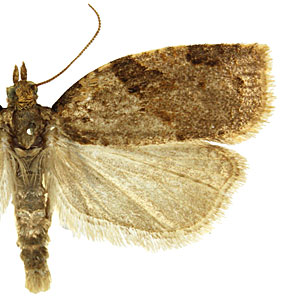Adult Recognition

FWL: 7.0-12.0 mm
Forewings are pale yellow to tan with brown to dark-brown markings. Most individuals have a costal spot, a median fascia that is well defined from the costa to 1/3 the distance to the dorsum, and dark-brown to black irrorations. Forewing coloration and pattern can vary extensively, and immaculate and melanic forms have been described. Males have a forewing costal fold.
In the Nearctic, C. spectrana is most likely to be confused with Clepsis fucana. Males of the two species are easily separated by the costal fold that is present in C. spectrana and absent in C. fucana. Females can be separated by the presence of a signum in the corpus bursae of C. spectrana; C. fucana females lack a signum.
Males have been captured in pheromone traps using pheromones from several other species, including Cacoecimorpha pronubana and Pandemis heparana.
Larval Morphology

Late instar larvae are 18-25 mm in length. The abdomen is brown to olive-green with conspicuous whitish pinacula and a pale subspiracular lateral line. The head and prothoracic shield are dark brown to black. An anal comb is present with 6-8 long teeth.
Larvae of C. spectrana are commonly intercepted at U.S. ports of entry on peppers (Capsicum) and cut flowers arriving from the Netherlands.
Biology

Clepsis spectrana completes 2-3 annual generations. Adults are present in May to July and again in August and September.
Females lay eggs in small masses on the host plant. Larvae feed in webbed leaves or flowers, and may cause considerable damage to foliage and developing fruits. Mid-instar larvae of the second or third generation overwinter until the following spring. Pupation occurs in the final larval shelter or in dead leaves.
Host plants
Larvae are polyphagous and have been recorded feeding on plants in more than a dozen families. In Europe, Clepsis spectrana is an important pest of strawberry, blackberry, hops, and blackcurrant. It is also a serious pest of floriculture in greenhouses and has been recorded damaging a variety of flowering and ornamental plants.
| Family | Genus/species | Common name |
| Aquifoliaceae | Ilex L. | holly |
| Asteraceae | Artemisia maritima L. | sea wormwood |
| Asteraceae | Tripolium pannonicum (Jacq.) Dobrocz. | sea aster |
| Begoniaceae | Begonia L. | begonia |
| Cannabaceae | Humulus lupulus L. | common hop |
| Caryophyllaceae | Dianthus L. | pink |
| Cyperaceae | Scirpus L. | bulrush |
| Cyperaceae | Scirpus sylvanticus L. | |
| Geraniaceae | Pelargonium L'Her. ex Aiton | geranium |
| Grossulariaceae | Ribes L. | currant |
| Iridaceae | Iris L. | iris |
| Iridaceae | Iris pseudacorus L. | paleyellow iris |
| Oleaceae | Syringa L. | lilac |
| Onagraceae | Epilobium L. | willowherb |
| Onagraceae | Epilobium palustre L. | marsh willowherb |
| Plumbaginaceae | Limonium vulgare Mill. | Mediterranean sea lavender |
| Poaceae | Phragmites australis (Cav.) Trin. ex Steud. | common reed |
| Primulaceae | Cyclamen L. | cyclamen |
| Rosaceae | Filipendula ulmaria (L.) Maxim. | queen of the meadow |
| Rosaceae | Fragaria L. | strawberry |
| Rosaceae | Malus Mill. | apple |
| Rosaceae | Potentilla L. | cinquefoil |
| Rosaceae | Pyrus L. | pear |
| Rosaceae | Rosa L. | rose |
| Rosaceae | Rubus L. | blackberry |
| Rosaceae | Spiraea L. | meadowsweet |
| Solanaceae | Capsicum annuum L. | cayenne pepper |
| Solanaceae | Capsicum L. | pepper |
| Urticaceae | Urtica dioica L. | stinging nettle |
| Urticaceae | Urtica L. | nettle |
| Violaceae | Viola L. | violet |
| Vitaceae | Vitis L. | grape |
Distribution

Clepsis spectrana is widely distributed across Europe, ranging as far east as Turkey and Kazakhstan. The earliest record in North America is a single specimen collected in British Columbia in 1950. It was "rediscovered" feeding on raspberry, currant, spruce, and cedar in the early 1990s in British Columbia, and the first U.S. record was collected in Washington in 1997. It is currently present in western Washington, although it has not yet reached pest status.
References

Bradley, J. D., W. G. Tremewan and A. Smith. 1973. British Tortricoid Moths - Cochylidae and Tortricidae: Tortricinae. The Ray Society, London, England.
Dang, P., R. Duncan and S. Fitzpatrick. 1996. Occurrence of two palearctic species of Clepsis Guenee, C. spectrana Trietschke and C. consimilana (Hubner) (Tortricidae), in British Columbia, Canada. Journal of the Lepidopterists' Society 50: 321-328.
LaGasa, E. 1999. 1998 western Washington pheromone-trap delimiting survey for Clepsis spectrana (Treitschke), the straw-colored tortrix moth. 1998 Entomology Project Report, Laboratory Services Division, Washington State Department of Agriculture. 3 pp.
Meijerman, L. and S. A. Ulenberg. 2000. Arthropods of Economic Importance: Eurasian Tortricidae. Arthropods of Economic Importance series. ETI/ZMA.
Razwoski, J. 1979. Revision of the genus Clepsis Guenee (Lepidoptera, Tortricidae). Part I. Acta Zoologica Cracoviensia. 23: 101-198.
Razowski, J. 2002. Tortricidae of Europe, Vol. 1, Tortricinae and Chlidanotinae. Frantisek Slamka, Slovakia. 247 pp.







